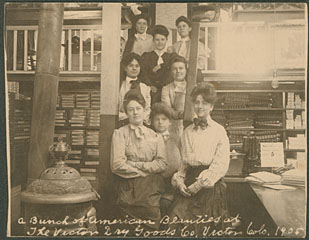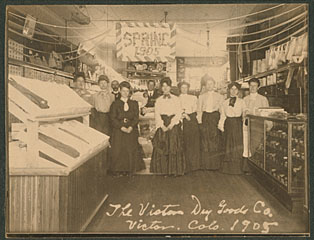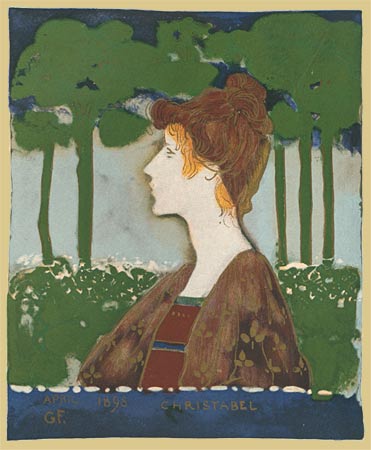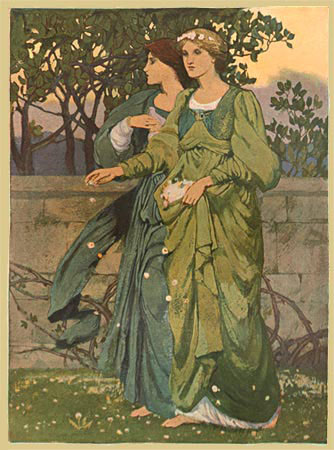Colorado History
 As the Victorian era waned at the end of the 19th century, a new decorative arts aesthetic, the Arts and Crafts Movement, emerged in England and America. Soon after our State's founding in 1876 (the same year of our country's 100th birthday and the Philadelphia Centennial Exposition), the Movement came to the United States.and to Colorado.
As the Victorian era waned at the end of the 19th century, a new decorative arts aesthetic, the Arts and Crafts Movement, emerged in England and America. Soon after our State's founding in 1876 (the same year of our country's 100th birthday and the Philadelphia Centennial Exposition), the Movement came to the United States.and to Colorado.
By 1898 in Denver, a group of enlightened artists, craftsmen and women had started the Denver Artists' Club, whose members included artist Henry Read and socialite Elizabeth Spaulding. Five years after this group was founded, they added another branch called the Art Crafts Department.
Writing in the Denver Post, Read said, "due to the rise in America of the philosophies of Ruskin, William Morris, Charles Wagner and Leo Tolstoy, and that art after all is Man's expression of joy in his work. They should honor this expression with annual exhibitions of this art craftsmanship."
This was perhaps the real beginning of the movement in Colorado. Ellen D'Arcy Gaw, a girl raised in Leadville, had made a name for herself as a designer and craftswoman in her studies at the Art Institute School. She would soon begin a partnership with Dirk Van Erp in San Francisco, producing some of the best copper work of the early 20th century.
 Also just after 1900, a famous couple - Artus and Ann Van Briggle - would realize their dream of an art pottery producing their designs in local clays with Artus' famous matte glazes in Colorado Springs, where the company was still in operation until 2011. Many art exhibitions from Pueblo to Fort Collins in the early 1900s showed the work of these talented and relatively undiscovered, craftsmen and women.
Also just after 1900, a famous couple - Artus and Ann Van Briggle - would realize their dream of an art pottery producing their designs in local clays with Artus' famous matte glazes in Colorado Springs, where the company was still in operation until 2011. Many art exhibitions from Pueblo to Fort Collins in the early 1900s showed the work of these talented and relatively undiscovered, craftsmen and women.
Watch our vidieo: History of CACS
Learn more about the roots of the Arts and Crafts movement.
The International Arts and Crafts Movement
 The Arts and Crafts Movement began in 1860s England with the ideas of philosopher John Ruskin and designer and poet William Morris. These influential thinkers idealized medieval times, believing that society would benefit from a return to a pre-Industrial Revolution economic system in which workers and their painstaking handiwork were highly regarded.
The Arts and Crafts Movement began in 1860s England with the ideas of philosopher John Ruskin and designer and poet William Morris. These influential thinkers idealized medieval times, believing that society would benefit from a return to a pre-Industrial Revolution economic system in which workers and their painstaking handiwork were highly regarded.
During the Middle Ages, a core belief was that pride of workmanship and a sense of accomplishment were social benefits that went hand in hand with fine design and well-made goods. With craftsmen enjoying an elevated stature, and the guild system monitoring their efforts, the items produced during this period were of the highest caliber.
However, not all of the exponents of the British Arts and Crafts Movement rejected manufacturing in favor of handcrafting. The Englishman Christopher Dresser was one notable exception who, because he thought most machine processes were flawed, proposed reinventing machinery to ensure quality designs and products. Even William Morris, considered the father of the Arts and Craft Movement, believed that machines could be used to relieve sheer drudgery, provided that the rest of the work was done carefully by hand.
While such lofty thinking was admirable, it unfortunately was unrealistic, because in the end the lovingly crafted (and highly coveted) pieces created during this time could only be afforded by the very wealthy. The dream of a middle-class society made happy and whole by a return to the basic, simple styles of the past never really materialized. What persevered instead was the concept that people could enjoy "the best of the good life" by surrounding themselves with quality and style.
From about 1895-1920, the Arts and Crafts Movement found its own expression in North America, evolving into a style distinctly different from its British counterpart. After America's own proponents - Elbert Hubbard of the Roycroft Shops in East Aurora and Gustav Stickley of United Crafts in Syracuse - visited Great Britain for an immersion in Arts and Crafts philosophy, they returned to their respective workplaces in New York State to put some new theories into practice.
The difference was that these (and other) American communities embraced - rather than abandoned - the machine, so that good design and quality workmanship became more affordable, at least at the upper-middle-class level. And, as publications like The Craftsman (published by Stickley) and The Philistine and The Fra (produced by the Roycrofters) detailed these new attitudes to their subscribers (while Hubbard himself went on the lecture circuit), the Movement went mainstream.
 This new school of thought - which also revered nature and its inherent ability to heal spiritually and physically - soon gave birth to a renewed appreciation for the environment that created America's national parks (along with the National Geographic Society and the Sierra Club). This paradigm shift back to the land and to simpler times helped make "wilderness escapes" popular, with the wealthy building personal retreats in the forms of rustic lodges, country cabins and seaside bungalows. It also helped preserve long-overlooked and under-appreciated Native American design traditions. These primitive baskets, pottery and weavings were natural enhancements to the interiors of these getaway retreats.
This new school of thought - which also revered nature and its inherent ability to heal spiritually and physically - soon gave birth to a renewed appreciation for the environment that created America's national parks (along with the National Geographic Society and the Sierra Club). This paradigm shift back to the land and to simpler times helped make "wilderness escapes" popular, with the wealthy building personal retreats in the forms of rustic lodges, country cabins and seaside bungalows. It also helped preserve long-overlooked and under-appreciated Native American design traditions. These primitive baskets, pottery and weavings were natural enhancements to the interiors of these getaway retreats.
As many "pilgrims" in search of beauty, nature and health cures began to explore America (particularly the Wild West and the California coastline), an admiration for indigenous building styles developed. The term "Mission" was coined by who were inspired by the 300-year-old Spanish missions in the Southwest, and the term "Prairie" was invented to describe the low, flat houses designed to match the Midwestern landscape (particularly those by Frank Lloyd Wright). Each of these styles had their own vernacular expression, where natural and indigenous materials not only became an integral part of the overall design but helped blend the furniture into the homes and the buildings into their surroundings.
In sum, the Arts and Crafts ideal and philosophy fit the American ethic of work, health, wealth, and individuality so well that it became the style of the times, influencing architecture, interior design and even social behavior. Because the style itself depends on simplicity and harmony among the home's many elements, and the lifestyle it advocates is holistic and planet-friendly, today it is even more relevant now than it was 100 years ago. What began as an adverse reaction to the technological progress launched by the Industrial Revolution has resulted in an ongoing appreciation for creations of the "head, heart and hand."
